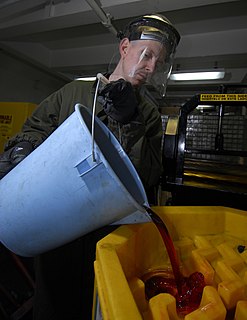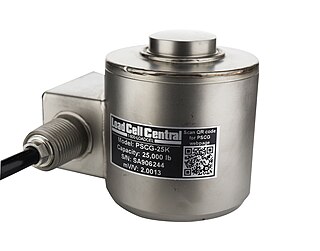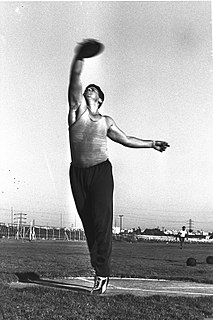
A shock absorber or damper is a mechanical or hydraulic device designed to absorb and damp shock impulses. It does this by converting the kinetic energy of the shock into another form of energy which is then dissipated. Most shock absorbers are a form of dashpot.

A forklift is a powered industrial truck used to lift and move materials over short distances. The forklift was developed in the early 20th century by various companies, including Clark, which made transmissions, and Yale & Towne Manufacturing, which made hoists. Since World War II, the use and development of the forklift truck have greatly expanded worldwide. Forklifts have become an indispensable piece of equipment in manufacturing and warehousing. In 2013, the top 20 manufacturers worldwide posted sales of $30.4 billion, with 944,405 machines sold.

A hydraulic fluid or hydraulic liquid is the medium by which power is transferred in hydraulic machinery. Common hydraulic fluids are based on mineral oil or water. Examples of equipment that might use hydraulic fluids are excavators and backhoes, hydraulic brakes, power steering systems, transmissions, garbage trucks, aircraft flight control systems, lifts, and industrial machinery.
Joule heating, also known as resistance heating and Ohmic heating, is the process by which the passage of an electric current through a conductor produces heat.

An O-ring, also known as a packing or a toric joint, is a mechanical gasket in the shape of a torus; it is a loop of elastomer with a round cross-section, designed to be seated in a groove and compressed during assembly between two or more parts, creating a seal at the interface.
Strength training is a type of physical exercise specializing in the use of resistance to induce muscular contraction, which builds the strength, anaerobic endurance, size of skeletal muscles and bone density.

Hydraulic machines use liquid fluid power to perform work. Heavy construction vehicles are a common example. In this type of machine, hydraulic fluid is pumped to various hydraulic motors and hydraulic cylinders throughout the machine and becomes pressurised according to the resistance present. The fluid is controlled directly or automatically by control valves and distributed through hoses, tubes, and/or pipes.

The electronic–hydraulic analogy is the most widely used analogy for "electron fluid" in a metal conductor. Since electric current is invisible and the processes at play in electronics are often difficult to demonstrate, the various electronic components are represented by hydraulic equivalents. Electricity was originally understood to be a kind of fluid, and the names of certain electric quantities are derived from hydraulic equivalents. As with all analogies, it demands an intuitive and competent understanding of the baseline paradigms.
Hydraulic conductivity, symbolically represented as , is a property of vascular plants, soils and rocks, that describes the ease with which a fluid can move through pore spaces or fractures. It depends on the intrinsic permeability of the material, the degree of saturation, and on the density and viscosity of the fluid. Saturated hydraulic conductivity, Ksat, describes water movement through saturated media. By definition, hydraulic conductivity is the ratio of velocity to hydraulic gradient indicating permeability of porous media.

Hydraulic head or piezometric head is a specific measurement of liquid pressure above a vertical datum.

Lime is a calcium-containing inorganic mineral composed primarily of oxides, and hydroxide, usually calcium oxide and/ or calcium hydroxide. It is also the name for calcium oxide which occurs as a product of coal-seam fires and in altered limestone xenoliths in volcanic ejecta. The word lime originates with its earliest use as building mortar and has the sense of sticking or adhering.

A load cell is a type of transducer, specifically a force transducer. It converts a force such as tension, compression, pressure, or torque into an electrical signal that can be measured and standardized. As the force applied to the load cell increases, the electrical signal changes proportionally. The most common types of load cell used are hydraulic, pneumatic, and strain gauge.

Survival, Evasion, Resistance, and Escape (SERE) is a program, best known by its military acronym, that provides U.S. military personnel, U.S. Department of Defense civilians, and private military contractors with training in evading capture, survival skills, and the military code of conduct. Established by the U.S. Air Force at the end of World War II, it was extended and consolidated during the Vietnam War (1959–1975) to the U.S. Marine Corps, and U.S. Navy and in the late 1980s to the U.S. Army. Most higher level SERE students are military aircrew and special operations personnel considered to be at high risk of capture.

An exercise machine is any machine used for physical exercise. These range from simple spring-like devices to computerized electromechanical rides to recirculating-stream swimming pools. Most exercise machines incorporate an ergometer. An ergometer is an apparatus for measuring the work a person exerts while exercising as used in training or cardiac stress tests or other medical tests.
Frac or FRAC may refer to:
Hydraulic exercise equipment is a form of exercise machine used in a number of strength training programs. They are most often found in circuit training gyms.
The groundwater energy balance is the energy balance of a groundwater body in terms of incoming hydraulic energy associated with groundwater inflow into the body, energy associated with the outflow, energy conversion into heat due to friction of flow, and the resulting change of energy status and groundwater level.

An oleo strut is a pneumatic air–oil hydraulic shock absorber used on the landing gear of most large aircraft and many smaller ones. This design cushions the impacts of landing and damps out vertical oscillations.

Gideon Ariel is an Israeli authority in biomechanics, as well as a former Olympic track and field athlete who competed in the shot put and discus throw.












